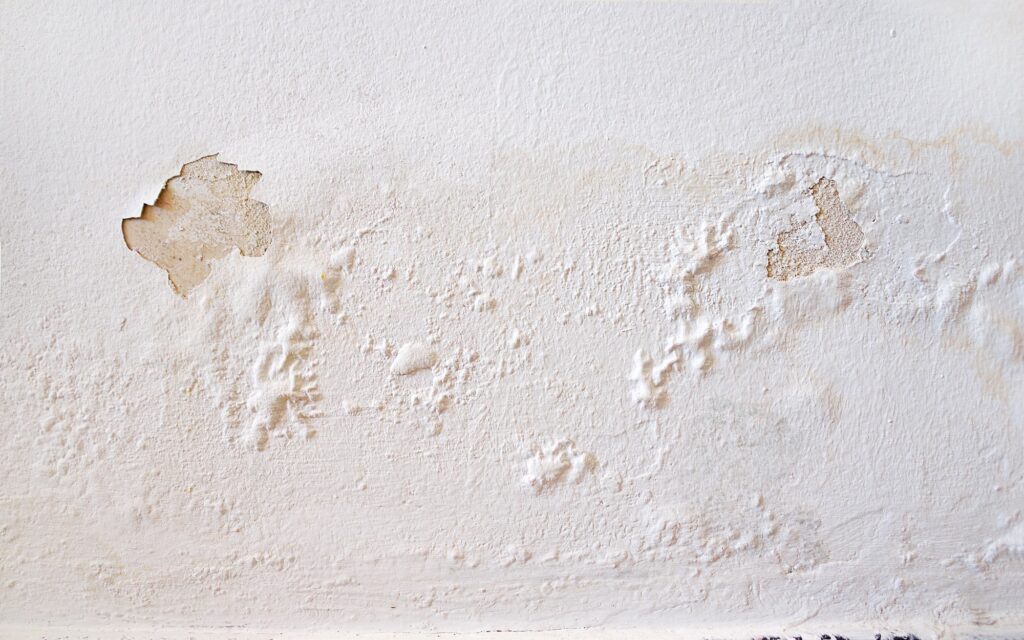Water damage in your home can be stressful and lead to serious problems if you don’t address it right away. Whether it’s from a burst pipe, a leaking roof, or a flooded basement, the effects can reach far beyond what you see on the surface. Repairing water damage quickly is the best way to protect your property and avoid expensive repairs down the road.
You might notice stains, warped walls, or even the smell of mold after water exposure. Taking action as soon as possible not only minimizes damage but also helps prevent health risks like mold growth. Professional water damage repair is available day or night to help restore your home and keep your family safe.
Identifying Water Damage
Spotting water damage early can help you prevent more problems and big repair bills. Focus on signs in your home’s structure, check how far the damage has spread, and learn the different categories of water damage.
Common Signs of Water Damage
Water damage often shows up as stains, soft spots, or discoloration on walls and ceilings. Paint may bubble, peel, or crack. You might also notice warped floors or a musty smell in the air.
Look for places with high moisture, like under sinks, behind toilets, and around windows. Mold growth is another strong clue. Hidden water damage can be found with a flashlight or by feeling for damp spots.
Use a checklist to make inspections easier:
- Stains or dark spots
- Swollen or warped surfaces
- Musty or damp smells
- Peeling paint or wallpaper
- Mold or mildew
Checking these areas can help you find problems before they get worse.
Assessing the Extent of Damage
Once you spot the damage, you need to figure out how much area is affected. Check if the damage is just at the surface or goes deeper inside walls and floors. Press gently on surfaces to feel for softness, which usually means more damage underneath.
Use a moisture meter to find hidden dampness. Make sure to check for leaks that could be coming from pipes, roofs, or windows.
If the damage covers a large area or the materials are soaked through, it might be time for professional help. Knowing what parts of your home are wet helps you plan your repair work more effectively.
Types of Water Damage
Not all water damage is the same. Experts often group water damage into three main categories based on the source and cleanliness:
| Type | Description | Risk level |
| Clean Water | Water from pipes or rain, safe if quickly removed | Low |
| Gray Water | Used water from sinks or washing machines | Medium |
| Black Water | Water with sewage or chemicals | High |
Each type affects how you should clean and repair the area. Clean water is easiest to manage, while gray and black water can carry germs or chemicals. Identifying the type helps you pick the right fix and stay safe.
Steps to Repair from Water Damage
Handling water damage in your home means moving quickly and following a set of clear steps. If you act early, you can lower your repair costs and keep the damage from spreading.
Stopping the Source of Water
First, stop any more water from getting inside or spreading. Turn off your main water valve if a pipe bursts, or unplug a leaking appliance right away. For rain or floodwater, try to block entry with sandbags or plastic sheets.
It helps to check the area for safety. If there are any exposed wires or the water is near electrical outlets, shut off the power at the breaker. Don’t step into standing water that may have come in contact with electricity.
Look for the leak or broken pipe. Even small leaks can cause big problems if you don’t deal with them fast. After you stop the water, you can safely start removing items from the area.
Drying and Dehumidification
After stopping water, remove as much moisture as you can. Use towels to soak up small puddles. For larger amounts, you’ll need a wet-dry vacuum, mop, or pump. Open windows and doors to allow air flow.
Rent or buy several fans and place them around the room to speed up the drying process. Set up a dehumidifier to lower humidity, which helps stop mold from growing. Aim fans at wet floors, carpets, and walls.
Keep air moving day and night. It may take several days for everything to dry. You should check for damp spots under carpets and behind walls—wet insulation and drywall can hide water even when surfaces feel dry.
Cleaning and Disinfecting
Once everything is dry, cleaning is the next step. Throw away anything that can’t be saved, including soaked carpet padding, insulation, and some drywall. Hard surfaces need to be cleaned with soap and hot water first.
After cleaning, disinfect with a bleach solution or a disinfectant. This will kill germs and stop mold or mildew from starting to grow. Pay extra attention to items that touched flood water, as this may be contaminated.
Soft items like clothes or bedding may be saved if cleaned quickly in hot water. Upholstered furniture and rugs are harder to clean—if they were soaked for more than a day, they might need to be replaced.
Structural Repairs
When surfaces are dry and free of mold, repairs can begin. Damaged drywall, flooring, and woodwork must be replaced. Cut out water-damaged wall sections at least a foot above the visible damage area. Fresh drywall or paneling can then be installed.
Inspect wood framing for rot or warping. Replace any weakened pieces or treat with a proper wood preservative. Subfloors and joists sometimes need repairs too, especially if the water sat for a long time.
Finish by painting or sealing the new surfaces, making sure they are completely dry first. A professional restoration team may be needed for bigger repairs or if mold is found in several places.
Restoring and Preventing Future Damage

Effective water damage repair involves replacing ruined materials, making sure all mold is removed, and taking steps to protect your home from more damage.
Replacing Damaged Materials
Water can ruin drywall, insulation, floors, and even the framing in your home. Start by removing and discarding any soft or swollen drywall, soaked insulation, or warped flooring. Wood framing should be dried fully before you start repairs. If you spot signs of swelling, rot, or bad odors, these materials may also need to be replaced.
Use a moisture meter to check that everything is dry. Install new drywall and insulation only after you’re sure there’s no hidden dampness. Floors like carpet and pads that are soaked for more than a day usually must be replaced. For hard floors, look for cupping or lifting. Any stains or mold growth mean the material should be removed rather than repaired.
It’s important to clean and sanitize the area before putting in new materials. This step helps prevent bacteria and mold from coming back later on.
Mold Remediation Strategies
Mold grows fast in wet or damp places. Within 24 to 48 hours after water damage, mold can start to spread. You need to act quickly to stop this from happening. Start by removing wet items like carpets and furniture. Open windows and use fans or dehumidifiers to move out as much moisture as possible.
Use a bleach solution or commercial cleaner to wash surfaces that have been exposed to water. Keep in mind that bleach does not kill mold inside porous materials, so items like drywall or insulation with mold should be thrown away. Wear gloves, goggles, and a mask to protect yourself from mold spores. Seal off work areas with plastic to keep spores from spreading to clean parts of your home.
If the mold covers a large area or is hidden behind walls or under floors, a licensed contractor may be needed. Mold inspections and air quality testing can help ensure that the problem is gone before you start rebuilding.
Preventative Maintenance Tips
Keeping up with regular maintenance can really help you avoid surprise water damage and keep your home safer overall. Take a look at your pipes, faucets, and water heaters for leaks at least twice a year. It’s usually easier (and cheaper) to fix a small drip now than deal with a big mess later. Don’t forget to clean out your gutters and check those downspouts—standing water near your foundation is just asking for trouble.
Sealing up cracks around windows, doors, or in the siding goes a long way in keeping rain out. If you’ve got a basement or crawl space, a vapor barrier can help keep moisture at bay. Folks in flood-prone spots might want to think about installing a sump pump—and it’s worth checking that it actually works from time to time. Storing valuables off the floor in these areas is just smart, honestly.
Smart leak sensors and alarms can catch problems early, sometimes before you even notice them. Getting a pro to inspect things every so often adds a little extra peace of mind.
Frequently Asked Questions
Water damage cleanup brings up plenty of questions. You might wonder what repairs you’ll need, how to avoid making things worse, or if the damage you see is just the tip of the iceberg.
Is water damage permanent?
Not always. If you act quickly, a lot of water damage can be fixed or at least kept from getting worse. Materials like drywall or some flooring might stain or grow mold if water sits for too long, though. Still, with quick restoration, you can usually repair or replace damaged parts so it’s not a lasting issue.
What not to do after water damage?
Don’t use a vacuum to suck up standing water—it’s risky. Avoid touching anything electrical that’s wet, and definitely don’t turn on ceiling fans or lights in water-damaged areas. Waiting to call for help is a mistake too; water can lead to mold and bigger problems fast.
How do you know if water damage is serious?
Look for things like warped walls, sagging ceilings, mold, musty odors, or peeling paint. If you notice stains spreading or soft spots in the floor, that’s usually a sign things are worse than they look. Sometimes you just can’t see it all yourself, so bringing in a professional to check hidden areas isn’t a bad idea.
Can you paint over water damage?
Painting right over water damage? Honestly, that’s asking for trouble. If the spot’s still damp or hasn’t been fixed up, you’re just covering up a problem that’s bound to resurface—sometimes literally. Moisture and even mold can sneak right through the paint. It’s best to let everything dry completely, handle any repairs, and seal things up before you even think about picking up a brush.
